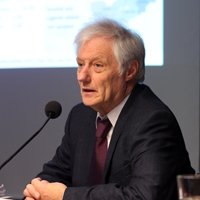Public Opinion in the Divided Donbas: Results of a January 2022 Survey on Both Sides of the Contact Line
Central to the current Ukraine-Russia crisis is the territorial conflict in the Donbas in eastern Ukraine. It is the unsettled site of an eight year war that has resulted in more than 14,000 deaths, millions of displaced persons, and continued skirmishes along the line of control. While the Kyiv government controls the western part of the Donbas, the eastern side is run by separatist authorities supported by Russia. Diplomatic dialogues often overlook the views of ordinary people in conflict zones. What precisely do people in the Donbas want?
Experts John O’Loughlin, Gwendolyn Sasse, and Gerard Toal presented key results from a large representative phone survey of 4,025 respondents from both sides of the territorial divide. Blame for the ongoing conflict as well as the current escalation, preferences for final status options for the region, reactions to a possible Russian invasion, trust in political leaders, and war experiences were analyzed.
Read a recent Monkey Cage blog on the data.
Selected Quotes
John O’Loughlin
“We’re talking about the Donbas in its broader terms of the two full oblasts. And then when we talk about the line of contact, we’re talking about the line that’s marked on this map. On the one side, we have the so-called Luhansk People’s Republic and then the Donetsk People’s Republic. And on the other side, of course, the area we generally refer to as the government controlled area. So that’s kind of the geographic background just so that everybody knows the two areas. So the design here is to repeat exactly the same questionnaire in all the locations with three different companies.”
“The one thing I’m going to talk about are ‘who do you blame for the conflict’ and we have two blame questions: one about the ongoing conflict—in other words the situation in 2014. And then we have one about the current escalation in the conflict, so I’m going to report it here, according to the four… surveys, the three companies. And the reason for that is because of questions regarding how respondents are answering the questions according to who’s phoning from where. So, again, you’ll see big differences across the companies, so if I put the category ‘Ukrainian government and the West’ into one block and then the ‘Russian government and the separatist republic leaders’ into another, you’ll see again, significant differences across.”
“What I will draw your attention to is how similar the R research and the KIIS-NGCA ratios are and then how different this is, the green bar, the ratio is with the Levada result. Again, the one thing that kind of struck me about this is that it’s not a symmetrical blame. In other words, people who answer in the separatist republics in the no-government controlled areas tend to blame the West and the Kyiv government, whereas the same kind of reciprocation is certainly present, in other words, people in the government-controlled areas do blame the Russian government… But the one thing is there is a lot of blame associated with their own government.”
Gwendolyn Sasse
“When we compare these results that clearly are quite far apart, if we compare, however, the Levada results from January 2022, to the Levada results from 2020, we see an increase—I think then it was about 50 percent—saying that the territories should become part of the Russian Federation. And now we’re here at about 70%, so that sentiment measured by Levada has increased, whereas if we look at the KIIS data for the non-government-controlled areas, we can compare it to the source data that was collected at the end of 2019 with our research.”
“It’s also problematic not to try to get individuals in these territories that we have almost no access to that we know little about, and we say things about the population, but we don’t really get to it. Sometimes it’s also hard to do this on the government controlled side, close to the contact line. So I think the three of us share this assumption that one should try and be as open about all methodological issues and challenges.”
“If we focus on who’s to blame for the recent escalation then we see that there is actually, maybe I thought, surprisingly high number of people—or share of people—in the government controlled areas…who blame Ukraine for this, as much as they blame Russia for this. So as you said, on the non-government controlled area side this divide does not exist and yes on the non-government controlled side and the blame for Ukraine is higher but when dealing with 25% non-government controlled areas both surveys combined and sort of 35 to a bit over 40 so that to me I think suggest how the areas closest to the contact line on the government controlled side also feel left behind by Kiev and what that fear most of course is that there’s more and extended war and protracted conflict.”
Gerard Toal
“The highest strongly agree in this survey (‘it doesn’t matter to me which country I live in; all I want is a good salary and then a good pension’) was in the KIIS surveys, in both the government-controlled areas and the non-government controlled areas, and it was virtually equal. And then strongly agree, that’s not simply the combined figure we have here, and then that was at virtually equal at 30%. And so almost one third strongly agreed with that. And then the highest strongly disagree was in the KIIS survey, in the government controlled areas, at 24%. And the highest refuse was in the KIIS survey in the non-government controlled areas. But that was only 14%, but still it was the highest refused, which gets at sort of the difficulty of that particular survey and the degree in which we need to commend KIIS.”
“These de facto states are real places with real people struggling to try to orientate themselves in a world where they are a geopolitical and instruments, territorial levers in larger geo-political games, and obviously we see that playing itself out right now. And so there is a disjuncture between that goal, sort of instrumentalize them in order to fulfill a geopolitical goal on the part of Russia and then looking after their welfare.”
“Having a state that is functional that serves its citizens and provides good social services is absolutely vital for legitimacy. It will attract people and right now that is not something that has happened. In both those areas, you know they are suffering from economic decline and a relative depravation of basic social services and so we need to keep that front and center rather than the geopolitical issue.”
This event is part of the Wilson Center's Hindsight Up Front | Ukraine initiative.

Speakers



Moderator

Hosted By

Kennan Institute
The Kennan Institute is the premier US center for advanced research on Eurasia and the oldest and largest regional program at the Woodrow Wilson International Center for Scholars. The Kennan Institute is committed to improving American understanding of Russia, Ukraine, Central Asia, the South Caucasus, and the surrounding region through research and exchange. Read more

